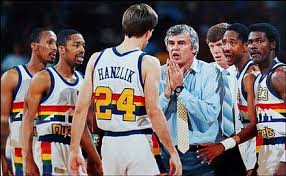The Placeholder: This coach is brought in for a limited time for one of two reasons. Either the team is looking for a star coach but one isn’t available at that time. Or more often, the team isn’t good enough yet to attract a top coach. The team needs a coach to fill a season or two so it can improve through the draft, trades or free agency. Once it is good enough to attract a top coach, the placeholder is jettisoned.
 When Del Harris was let go in Milwaukee 1992, longtime assistant Frank Hamblen was given an opportunity to be coach. The team was in disarray through retirements and a bad mix of players. Frank did his best to hold it together, but he was a better assistant than head coach.
When Del Harris was let go in Milwaukee 1992, longtime assistant Frank Hamblen was given an opportunity to be coach. The team was in disarray through retirements and a bad mix of players. Frank did his best to hold it together, but he was a better assistant than head coach.
The following year the Bucks brought in Mike Dunleavy to fix things and let go of Hamblen, who did pretty well, though. He latched on with Phil Jackson and was a key part of several championships in both Chicago and Los Angeles.
In Orlando in 1996, Brian Hill was let go in a messy situation. To calm the waters, the Magic let top assistant Richie Adubato take over for a season. Richie did a terrific job under the circumstances – Shaquille O’Neal had fled via free agency – and was liked by the players, but ownership didn’t think he had the needed stature for the organization.
After one season as “interim” coach – otherwise known as the kiss of death – the Magic brought superstar coach Chuck Daly out of retirement.
Irreconcilable Differences: Teams can play upwards of 100 games a season under intense pressure from all sides. Sometimes the message gets stale, players tune out the coach, or personalities clash. This is always the fault of the coach, no matter whose fault it really is.
Take Hill in Orlando. While there were stories of a player uprising and ultimatums from stars, the bottom line was the relationship between the team and coach was beyond repair. Something had to be done as things had gotten ugly, with no hope of a fix. Brian was a very hard-working, diligent coach, but things just got away from him. Like any marriage that goes south, it was time for a change.
The run is done, time to start over: Teams have a life span as stars age and retire and periodically comes a time to reboot. Usually a veteran coach does not want to stay through a multi-year rebuilding phase, and management wants a fresh, less expensive face on the bench until the team is get competitive again (see Placeholder).
Doug Moe had a very successful coaching career with San Antonio and Denver. After a 10-year run with the Nuggets in which he won Coach of the Year honors, the aging core was  disbanded and the team went into rebuilding mode.
disbanded and the team went into rebuilding mode.
Doug left on good terms as it was time to move on. He was signed to a four-year deal with the 76ers in one of the worst matches ever made. Doug was an ABA guy with a high-scoring, passing-game, crazy-man mentality. Philadelphia was a traditional, old-school franchise with a blue-collar fan base that was not ready for breakneck basketball. His mix of players never understood him as the team had amassed players used to a rigid system. He lasted only 56 games before “irreconcilable differences” did him in.
Appease the Star: This type of firing makes everyone look bad. When a coach is let go to make a player happy, it makes the team look weak and pandering, it makes the player look spoiled and entitled, and makes the coach look difficult to get along with. We all know the NBA is a player’s league. And while this seems like a relatively new phenomenon, it is as old as the game itself.
I remember talking to my dad about this once. He was one of the NBA’s pioneer stars from the 1940s and 1950s. When a star player was blamed for Hill’s firing, my dad commented on how many players got coaches fired when he was a player. “It happened all the time!” he said.
So don’t blame this one on “today’s player,” because “yesterday’s player” got plenty of coaches canned, too.
In looking at the decimation of the coaching ranks this offseason, see if you can recognize the pattern. And remember, the more things change, the more they stay the same.
Danny Schayes is a retired 18-year-veteran of the NBA, a professional broadcaster and aspiring author now penning weekly NBA columns for SheridanHoops. Follow him on Twitter.